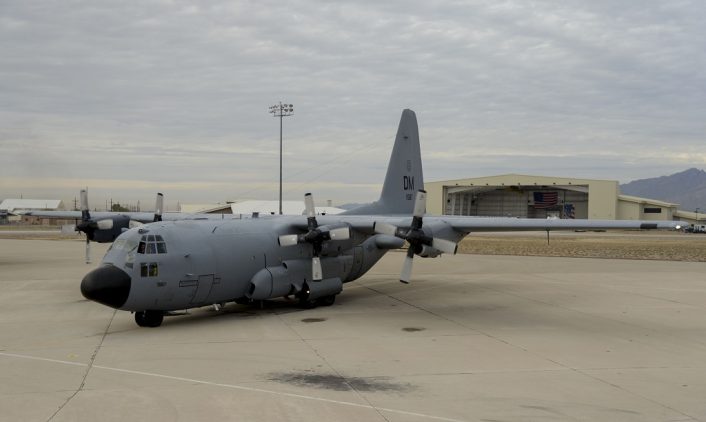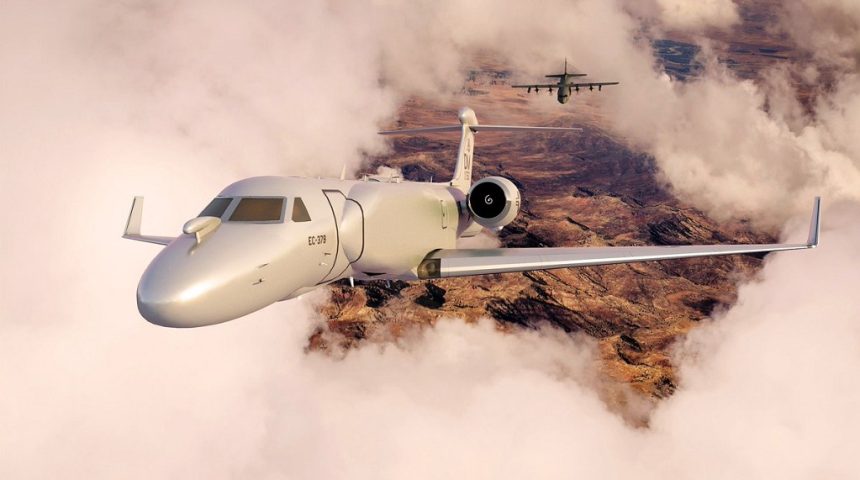SABER technology is part of a critical upgrade of the Compass Call system that will be rehosted on the EC-37B.
BAE Systems successfully flight tested its Small Adaptive Bank of Electronic Resources (SABER) technology for the new EC-37B on a U.S. Air Force EC-130H from Davis Monthan Air Force Base, Arizona. The company and Air Force’s personnel worked together during the flight test campaign that produced a total of 11 flights and assessed the correct functioning of this critical upgrade for the Compass Call system.
According to the statement from BAE Systems, SABER is a major technological advance that will allow the Compass Call weapon system to transition from hardware to software-based electromagnetic spectrum (EMS) warfare capability. The SABER system is built on a suite of Software Defined Radios (SDRs) using an open system architecture and will provide the backbone of the new EC-37B’s operating system.
“SABER allows flexibility to update systems without significant physical reconfiguration,” said Pam Potter, director of Electronic Attack Solutions at BAE Systems. “It also adapts to new applications as well as revisions to existing applications. It is the technology that will enable the U.S. Air Force to rapidly and proactively respond to emerging enemy threat systems.”
Additional testing this year will focus on simultaneity of engagement capacity, dynamic resource sharing, rapid integration, and operation of multiple additional applications to explore the vast possibilities of the upgraded Compass Call system and deploy the optimum 21st century electronic attack platform.
As you may know already, the Compass Call system is an airborne tactical electronic attack weapon system installed on a heavily modified version of the C-130 Hercules, called EC-130H Compass Call. This system disrupts enemy command and control communications, radars, and navigation systems and limits adversary coordination, which is essential for enemy force management. Together with the EA-18G Growler and the F-16CM Block 50/52 Fighting Falcon, the Compass Call is part of the US Suppression of Enemy Air Defense (SEAD) triad.
The EC-130H is operated by the 55th Electronic Combat Group (ECG) at Davis-Monthan AFB as a geographically separated unit of the 55th Wing based at Offutt AFB, Nebraska. The latter provides Intelligence, Surveillance and Reconnaissance (ISR), Electronic Warfare (EW), Command and Control (C2) and national treaty verification capabilities for the U.S. forces with numerous variants of the C-135 and C-130 airframes.

The EC-130H flew for the first time in 1981 and was delivered to the Air Force a year later. The aircraft, with a crew of 13 people (four responsible for flight and navigation and nine for the EA mission equipment), has been upgraded throughout the year from the initial Baseline 1 to the current Baseline 3. The Compass Call is one of the busiest assets of the entire US inventory, which took part in every conflict where US troops were engaged in combat, and is also longest continuously deployed Air Force asset, being deployed since 2002 in Afghanistan. After 40 years, however, the EC-130H is in need of a replacement.
Following the type’s retirement announced in 2014, the U.S. Air Force initiated the Compass Call Rehost program, which will move the current Compass Call systems from the EC-130H to the new EC-37B, based on the Gulfstream G550 Conformal Airborne Early Warning Aircraft (CAEW) airframe. As for the EC-130H, BAE Systems is the contractor for the Prime Mission Equipment (PME) and L3 Communications is the contractor for aircraft integration and depot maintenance.
The selection of the G550 was the conclusion of a series of assessments that led the Air Force to choose to rehost the existing Compass Call mission system onto a commercial derivative aircraft, resulting in a sole-source contract to L3 Communications and Gulfstream in 2017. Boeing and Bombardier protested but were later dismissed as the G550 CAEW was the only airframe available that would not need further development or certifications to be adapted to the Compass Call mission and has also been performing these types of special military missions for years with multiple operators.
Ten EC-37Bs, the firsts of which are currently being modified in Savannah (Georgia), are scheduled to replace entire EC-130H fleet. Some of the oldest EC-130H have already been divested, including the first one to be modified into this airborne electronic attack platform, with about ten aircraft still in service out of the original 14 built.
According to a 2020 planning of the 55th Wing available online, EC-37B testing should begin at Davis-Monthan AFB in January 2022 and the first five aircraft will be delivered to the Air Combat Command in 2023. These first five aircraft will host the Baseline 3 variant of Compass Call, while the remaining five aircraft are scheduled to receive the newer Baseline 4 variant currently in development, which will reportedly introduce a new low-band jammer system.
Available info mention that the EC-37B’s weight and operating costs will be cut in half compared to the EC-130H Compass Call, while also being able to perform its mission at higher altitudes and speed and longer ranges and durations. The G550-based aircraft will also be optimized to perform missions in Anti-Access, Area-Denial (A2/AD) environments, while also being able to be easily upgraded to face new threats thanks to its Modular Open Systems Architecture.
It is worth noting that a similar aircraft has been delivered to the U.S. Navy and should become operational this year, with the designation NC-37B, as the replacement for one of the three NP-3D “Billboard” Orions operated by VX-30 “Bloodhounds” at Naval Air Station Point Mugu (California). The aircraft, like the EC-37B, is a derivative of the G550 CAEW airframe and is equipped with telemetry systems and other specialized equipment for the range support role.









